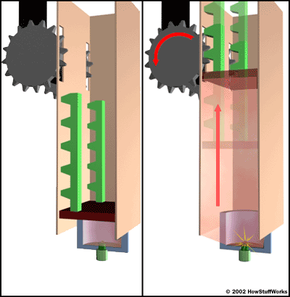The Pretensioner
The idea of a pretensioner is to tighten up any slack in the belt webbing in the event of a crash. Whereas the conventional locking mechanism in a retractor keeps the belt from extending any farther, the pretensioner actually pulls in on the belt. This force helps move the passenger into the optimum crash position in their seat. Pretensioners normally work together with conventional locking mechanisms, not in place of them.
There are a number of different pretensioner systems on the market. Some pretensioners pull the entire retractor mechanism backward and some rotate the spool itself. Generally, pretensioners are wired to the same central control processor that activates the car's airbags. The processor monitors mechanical or electronic motion sensors that respond to the sudden deceleration of an impact. When an impact is detected, the processor activates the pretensioner and then the airbag.
Advertisement
Some pretensioners are built around electric motors or solenoids, but the most popular designs today use pyrotechnics to pull in the belt webbing. The diagram below shows a representative model.
The central element in this pretensioner is a chamber of combustible gas. Inside the chamber, there is a smaller chamber with explosive igniter material. This smaller chamber is outfitted with two electrodes, which are wired to the central processor.
When the processor detects a collision, it immediately applies an electrical current across the electrodes. The spark from the electrodes ignites the igniter material, which combusts to ignite the gas in the chamber. The burning gas generates a great deal of outward pressure. The pressure pushes on a piston resting in the chamber, driving it upward at high speed.
A rack gear is fastened to one side of the piston. When the piston shoots up, the rack gear engages a gear connected to the retractor spool mechanism. The speeding rack rotates the spool forcefully, winding up any slack belt webbing.
